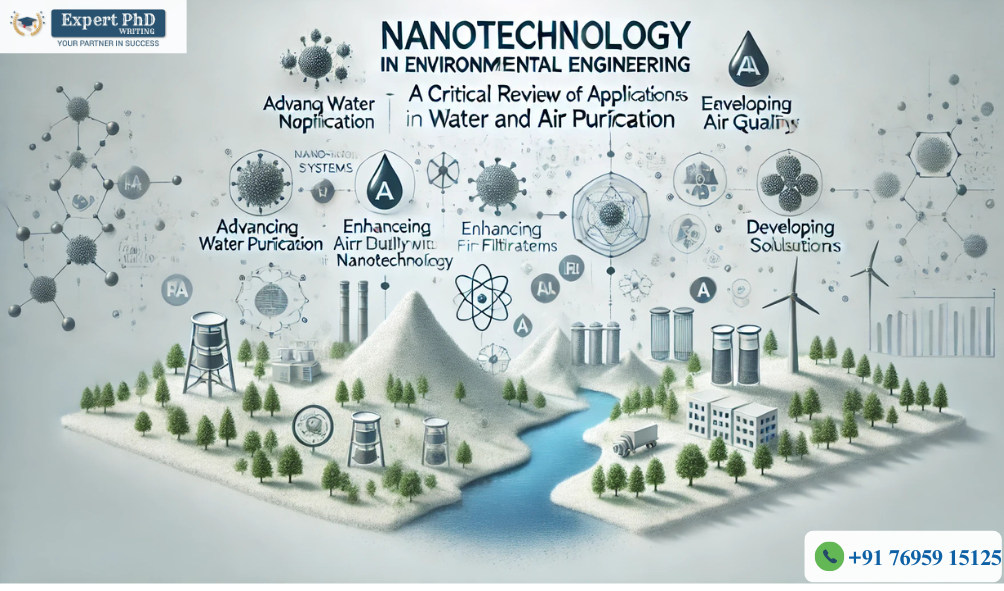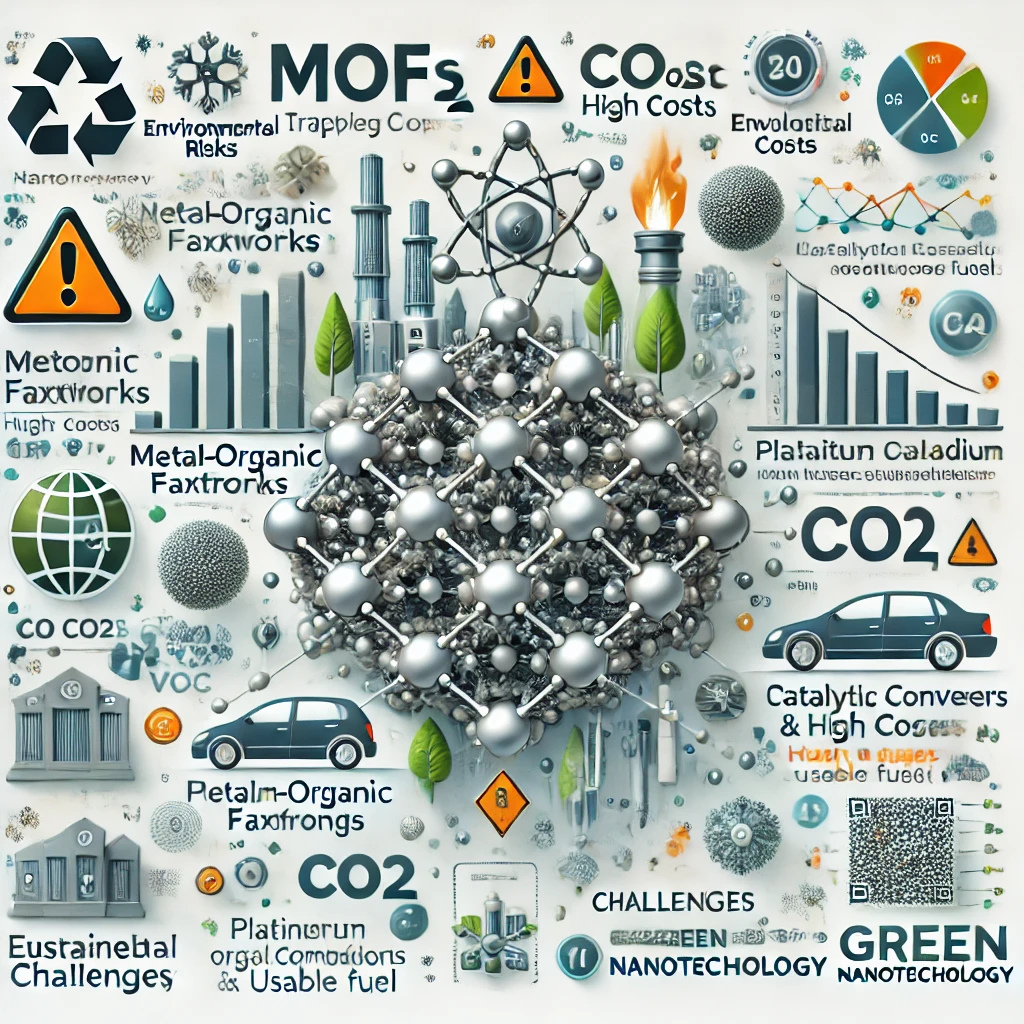
Nanotechnology in Environmental Engineering: A Critical Review of Applications in Water and Air Purification
Introduction
Nanotechnology, the manipulation of matter on an atomic and molecular scale, has transformed environmental engineering, especially in water and air purification. By creating materials at the nanoscale, engineers can harness unique properties—such as enhanced reactivity, larger surface area, and controlled pore sizes—to effectively address pollution. This critical review explores nanotechnology's applications in water and air purification, examines the benefits and risks, and discusses future research directions. With the increasing demand for clean resources, these innovative nanomaterials offer promising solutions but also raise concerns about environmental and human health impacts.
Applications in Water Purification
Nanotechnology has revolutionized water purification by enabling the removal of various contaminants, including heavy metals, organic compounds, and pathogens. Key nanomaterials used include:
- Carbon Nanotubes (CNTs): CNTs are renowned for their high surface area and strong adsorption capabilities, making them ideal for capturing heavy metals and organic pollutants. For instance, CNTs can effectively absorb mercury, lead, and other toxic metals, offering a potential solution to contaminated groundwater.
- Silver Nanoparticles: Known for their antibacterial properties, silver nanoparticles are widely used to disinfect water. They can eliminate bacteria and viruses more effectively than traditional disinfectants, such as chlorine, and with fewer harmful by-products.
- Nano-Photocatalysts: Titanium dioxide (TiO₂) nanoparticles are prominent photocatalysts that, under UV light, degrade organic pollutants, including pesticides and dyes. This photocatalytic activity transforms harmful chemicals into less toxic compounds, reducing environmental impact. Additionally, nano-photocatalysts require minimal energy input, making them suitable for sustainable water treatment (Avargani et al., 2023).

Applications in Air Purification
Nanotechnology also offers novel approaches to air purification, addressing pollutants like volatile organic compounds (VOCs), particulate matter, and greenhouse gases. Key applications include:
- Nanofiber Filters: Nanofiber filters, often made from materials like polyvinylidene fluoride, can capture fine particles, including PM2.5, that conventional filters miss. Their high surface area and porosity make them effective in trapping particulate matter, contributing to cleaner indoor and outdoor air.
- Metal-Organic Frameworks (MOFs): MOFs are highly porous materials that can trap gases such as CO₂ and VOCs. By binding to pollutants, MOFs reduce harmful emissions and improve air quality. Some MOFs can even convert CO₂ into usable fuel, showcasing potential applications in reducing greenhouse gas emissions.
- Catalytic Converters Using Nanocatalysts: Nanocatalysts, particularly platinum and palladium nanoparticles, are used in catalytic converters to reduce vehicle emissions. These nanomaterials lower the activation energy for chemical reactions, converting toxic gases into less harmful substances, thereby mitigating the impact of transportation on air pollution (Dey & Mehta, 2020).
Challenges and Risks
Despite their benefits, the application of nanotechnology in environmental engineering presents challenges.
- Environmental and Health Risks: Nanoparticles, due to their small size, can easily penetrate biological membranes, posing potential risks to human health and ecosystems. Studies have shown that certain nanoparticles can cause respiratory issues and cytotoxicity in aquatic organisms. For instance, silver nanoparticles, while effective as an antibacterial agent, may accumulate in aquatic life and disrupt microbial communities essential for ecosystem health (Zhang et al., 2019).
- Cost and Scalability: Producing nanomaterials like carbon nanotubes and MOFs can be costly and requires specialized equipment, making it challenging to implement at large scales. This financial barrier limits the widespread adoption of nanotechnology-based solutions, particularly in developing regions.
- Regulatory Challenges: There is a lack of comprehensive regulations governing the production and disposal of nanomaterials. As nanotechnology advances, establishing guidelines for safe usage, handling, and disposal is essential to prevent potential adverse effects on human health and the environment (Mazari et al., 2021).
Future Directions
Research into nanotechnology's environmental applications continues to grow, with a focus on enhancing the safety, efficiency, and scalability of nanomaterials. Green synthesis methods are emerging to create environmentally friendly nanoparticles, reducing the use of toxic chemicals in production. Additionally, multi-functional nanomaterials that can target multiple pollutants simultaneously are being developed, potentially simplifying water and air treatment processes.
Nanotechnology’s integration with artificial intelligence (AI) is also promising. AI can optimize the design of nanomaterials for specific pollutants, improving their efficiency and reducing costs. As these technologies evolve, they may play an essential role in sustainable development by providing cleaner air and water (Hassan et al., 2023).
Conclusion
Nanotechnology has made significant strides in environmental engineering, offering powerful tools for water and air purification. The use of nanomaterials such as CNTs, silver nanoparticles, and MOFs demonstrates their potential to address various pollutants effectively. However, challenges such as health risks, high costs, and regulatory gaps must be addressed to ensure safe and sustainable application. With continued research and responsible regulation, nanotechnology can contribute to cleaner and safer environmental engineering solutions.

References
- Avargani, V. M., Zendehboudi, S., Osfouri, S., & Rostami, A. (2023). Performance evaluation of a solar nano-photocatalytic reactor for wastewater treatment applications: Reaction kinetics, CFD, and scale-up perspectives. Journal of Cleaner Production, 421, 138240. https://doi.org/10.1016/j.jclepro.2023.138240 [Nano-Photocatalysts]
- Dey, S., & Mehta, N. S. (2020). Automobile pollution control using catalysis. Resources, Environment and Sustainability, 2, 100006. https://doi.org/10.1016/j.resenv.2020.100006 [Catalytic Converters]
- Hassan, S. A., Almaliki, M. N., Hussein, Z. A., Albehadili, H. M., Banoon, S. R., Al-Abboodi, A., & Al-Saady, M. (2023). Development of Nanotechnology by Artificial Intelligence: A Comprehensive Review. Journal of Nanostructures, 8, 19-32. https://doi.org/10.1142/S2212040920301529 [AI & Nanotechnology]
- Mazari, H. S., Rahman, M. H., & Rasul, M. G. (2021). Nanomaterials and their applications in environmental engineering. Journal of Environmental Management, 280, 111526. https://doi.org/10.1016/j.jenvman.2020.111526 [Nanomaterials & Regulations]
- Zhang, L., Lee, W., Lee, Y., & Li, X. (2019). Toxicity of silver nanoparticles in the environment. Journal of Environmental Science and Technology, 42, 9356-9363. https://doi.org/10.1021/acs.est.9b02712 [Toxicity of Silver Nanoparticles]